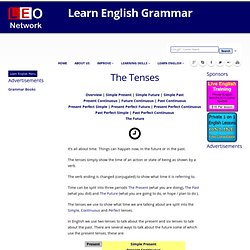

Past-English. Verb Tenses. Verb Tenses. In English, there are three basic tenses: present, past, and future.

Each has a perfect form, indicating completed action; each has a progressive form, indicating ongoing action; and each has a perfect progressive form, indicating ongoing action that will be completed at some definite time. Here is a list of examples of these tenses and their definitions: Simple Forms Present Tense Present tense expresses an unchanging, repeated, or reoccurring action or situation that exists only now. Past Tense Past tense expresses an action or situation that was started and finished in the past. Future Tense Future tense expresses an action or situation that will occur in the future. The speaker of the House will finish her term in May of 1998. The future tense can also be expressed by using am, is, or are with going to.
The surgeon is going to perform the first bypass in Minnesota. We can also use the present tense form with an adverb or adverbial phrase to show future time. The president speaks tomorrow. Verb Tenses. Summary: This handout explains and describes the sequence of verb tenses in English.

Contributors:Chris Berry, Allen Brizee, Elizabeth AngeliLast Edited: 2013-09-14 09:29:01 Strictly speaking, in English, only two tenses are marked in the verb alone, present (as in "he sings") and past (as in "he sang"). Other English language tenses, as many as thirty of them, are marked by other words called auxiliaries. Understanding the six basic tenses allows one to re-create much of the reality of time in their writing.
Simple Present: They walk Present Perfect: They have walked Simple Past: They walked Past Perfect: They had walked Future: They will walk Future Perfect: They will have walked Problems in sequencing tenses usually occur with the perfect tenses, all of which are formed by adding an auxiliary or auxiliaries to the past participle, the third principal part. ring, rang, rung walk, walked, walked Present Perfect 1. 2. 1. 2. 1. 2. Past Perfect 1. 2. The vegetables were raised before they were sold. Tenses. It's all about time.

Things can happen now, in the future or in the past. The tenses simply show the time of an action or state of being as shown by a verb. The verb ending is changed (conjugated) to show what time it is referring to. Time can be split into three periods The Present (what you are doing), The Past (what you did) and The Future (what you are going to do, or hope / plan to do ). The tenses we use to show what time we are talking about are split into the Simple, Continuous and Perfect tenses.
In English we use two tenses to talk about the present and six tenses to talk about the past. Simple Tenses The simple tenses are used to show permanent characteristics of people and events or what happens regularly, habitually or in a single completed action. Continuous Tenses The continuous tenses are used when talking about a particular point in time. Perfect Tenses The perfect tenses are used when an action or situation in the present is linked to a moment in the past.
Tenses.